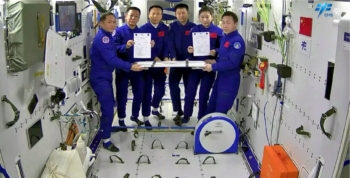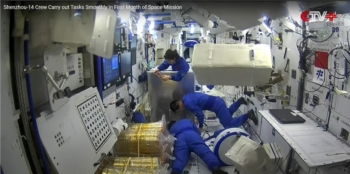Fresh from achieving another milestone in China’s space station program, a future agenda item includes building upon the orbiting complex and perhaps evaluating technologies needed for projected human space exploration of the Moon.
China is in position to further promote space station construction in the future, explains Wang Xiang, Space Station System Commander at the China Academy of Space Technology.
“As a space station, we are at the beginning of our application and development,” Wang told China Central Television (CCTV).
Extension module
Following the current station design, Wang said that an “extension module” can be launched to dock with the forepart of the in-orbit facility. That module, plugged into a new node, would leave more space for docking with subsequent space vehicles and offer a larger and more comfortable environment for crew members.
This evolving station design would also provide an environment, or a site, for better application of scientific payloads, Wang said, both inside the module and outside in free-space.

Shenzhou-14, Shenzhou-15 crew members in handover ceremony.
Credit: CMS/CCTV/Inside Outer Space screengrab
“For example, if we’re going to carry out manned lunar exploration in the future, then we have some of the spacecraft technologies — even some of the new generation of spaceship technologies — that can be verified in the outer space,” said Wang. Using the space station in this way, it becomes a very good platform, he added.
Following the plan
China’s future station ambitions have been bolstered by the recent return to Earth of the Shenzhou-14 crew, a space outing of six months duration.
The Shenzhou-14’s return capsule, carrying astronauts Chen Dong, Liu Yang and Cai Xuzhe, parachuted into the Dongfeng landing site in north China’s Inner Mongolia on Sunday.
“We completed the in-orbit missions following the plan. The astronauts all went out of the cabin in good health and everything was implemented as planned. The entire manned flight was perfect, without any abnormality,” said Shao Limin, deputy technological manager of manned spacecraft system with China Academy of Space Technology.
Solid foundation
Xu Chong, director of the China Astronaut Research and Training Center, said that the Shenzhou-14 crew stayed in space for 183 days and are all in good shape, both mentally and physically.
“Their return and landing were smooth too. So it has laid a solid foundation for the follow-up work on medical guarantee, medical and heath monitoring and the whole technological system throughout the space station operational period,” Xu told CCTV.
The Shenzhou-14 crew flew to the space station on June 5. During their stint in space, they completed multiple tasks, such as overseeing five rendezvous and dockings, performing three extravehicular activities, and conducted several science/technology experiments. They landed on December 4.
Many “firsts”
While in Earth orbit, the Shenzhou-14 trio chalked up many “firsts” in China’s space history: the first rendezvous and docking between two 20-ton-level spacecraft and the first in-orbit transposition of a space station module. They also set a record of making three spacewalks on a single flight mission.
Before departing for Earth, the Shenzhou-14 crew performed an in-orbit rotation of responsibility with the newly arrived, three Shenzhou-15 crew members – commander Fei Junlong, along with two newcomers, Deng Qingming and Zhang Lu. That crew made a 6.5 hours long “fast automated rendezvous and docking” with the country’s orbital complex on November 30.
Station status
“According to the standards of the mission outline, the Shenzhou-14 manned mission was a complete success,” said Lin Xiqiang, deputy director of the China Manned Space Agency (CMSA).
“With the Shenzhou-14 and Shenzhou-15 finishing the in-orbit rotation and Shenzhou-14 returning to the Earth safely, our planned mission of building the space station has completed,” Lin concluded.
For videos of the Shenzhou-14 mission highlights and projected growth of China’s space station, go to:







